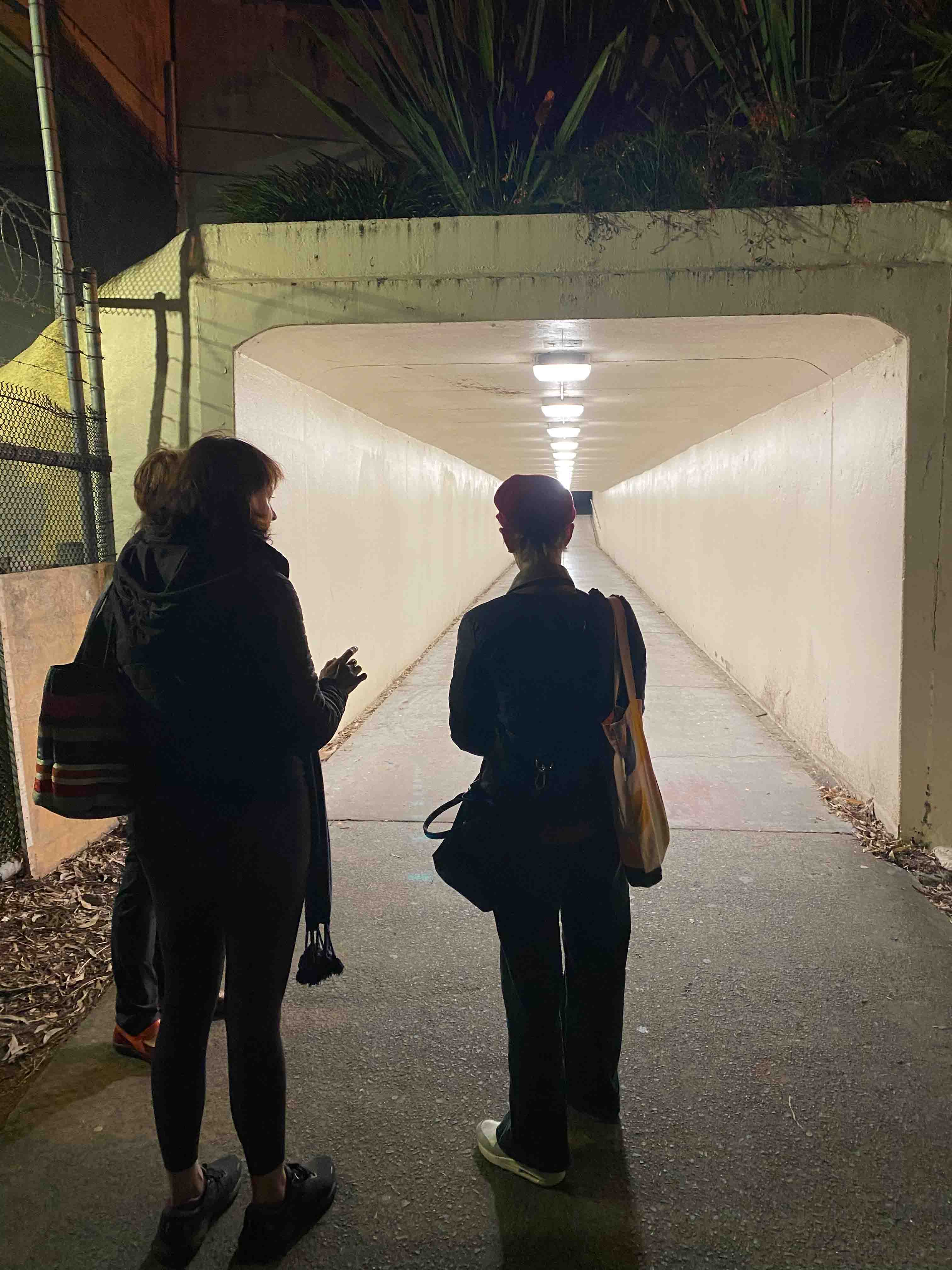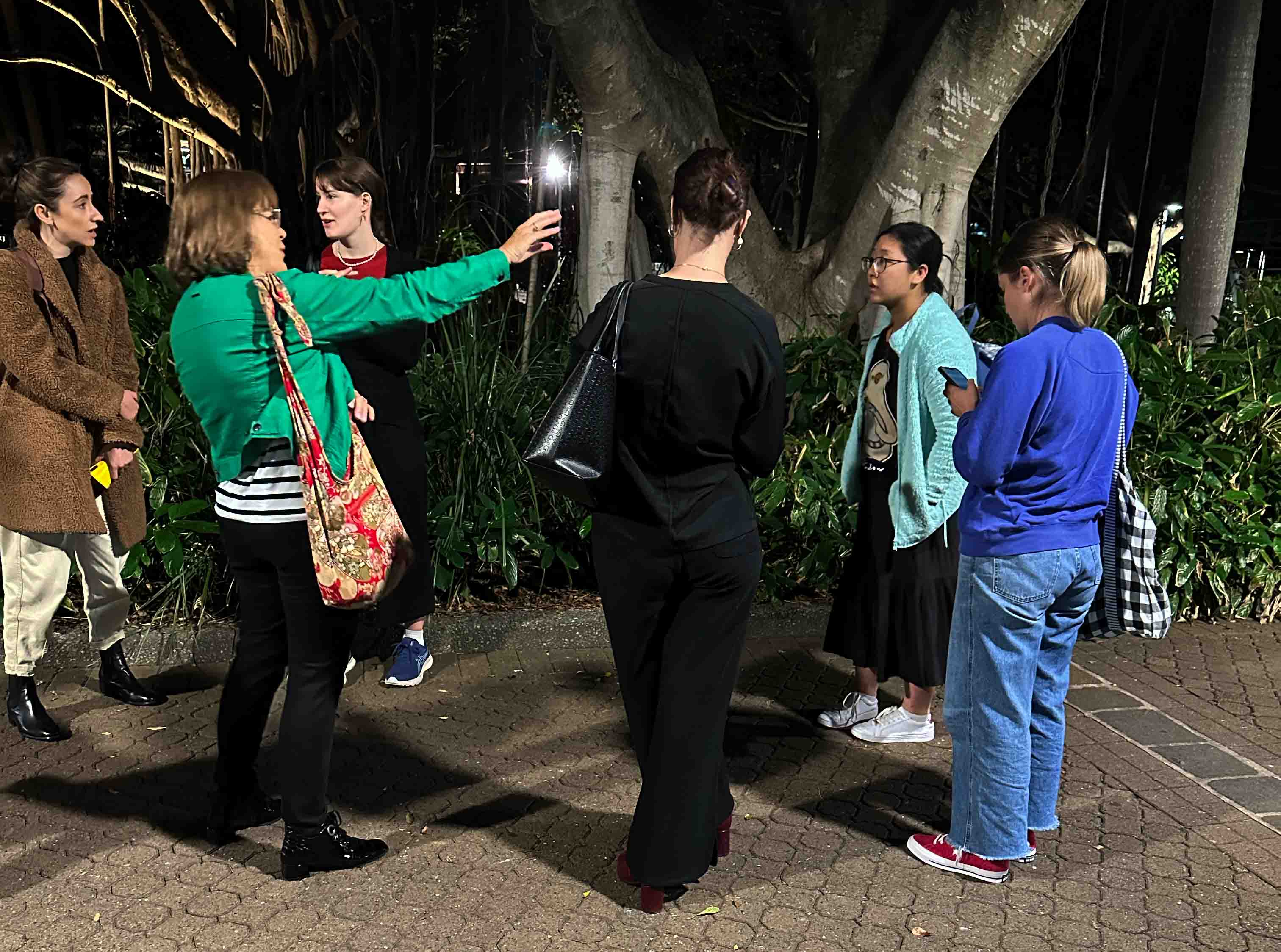Have you walked in a public space at night-time and tightly gripped your keys in your fingers, “just in case”? It’s a scenario that UQ researchers Dr Laurel Johnson and Stephanie Wyeth have each experienced, and it is something they have a “burning desire” to change.
Studies show that 1 in 2 women do not feel safe walking alone at night, and that young women are frightened for their physical safety. Recent media has highlighted that many women feel unsafe about, or avoid, night-time or early morning outdoor exercise, which poses potential health and wellbeing implications.
This International Women’s Day, UN Women is calling on communities around the world to take a stand against gender inequality by investing in women and supporting feminist change-makers – putting the focus on women-led projects like Safe Streets for Women and Girls, which advocate for change, equality and inclusivity.
The Safe Streets for Women and Girls project brings together UQ researchers in planning; two NGOs, one focused on stopping gender-based violence and one that advocates for more walkable places; community members; and business. The project gathers citizen science data through guided community “night walks” that assess feelings of safety in particular spaces of the city and uses that data to inform land managers and other decision-makers.
The project also creates a model for residents and organisations to carry out similar research and advocacy in their own communities.
Dr Johnson, Senior Research Fellow in the UQ Institute for Social Science Research, and Ms Wyeth, Senior Lecturer and Planner in Residence in the School of Architecture, Design and Planning, are key collaborators who are leading the mapping and data-gathering components of the project. The project is a collaboration with Zonta International and Queensland Walks.
“Australia ranks really low on national indicators around women's safety and being able to walk independently after dark, compared to other indicators of development,” Ms Wyeth says.
“The women behind this project – at Zonta Club of Brisbane, Queensland Walks, and Laurel and I at UQ – we are interested in doing more than our day job. We want to build momentum for change and make our cities safer for women and girls, particularly in the lead-up to the 2032 Brisbane Olympic and Paralympic Games.”
Feeling unsafe in public spaces at night-time is not exclusive to women and girls, but the research focuses on this group because of the alarming statistics around women feeling unsafe, “and because of their vulnerability,” Dr Johnson says.

The pilot Safe Cities Night Walk was held in collaboration with South Bank Corporation at Brisbane’s South Bank precinct in August 2023, attended by almost 40 people, mostly women and girls aged 18 to 74. The walk revealed some entry and exit points of concern, such as the Vulture Street pedestrian underpass, where 36% of respondents reported feeling unsafe and 43% reported feeling very unsafe.
During the one-hour walk, small groups visited eight designated sites within the precinct, and completed a digital survey created by the UQ research group, which participants accessed on site via their mobile phones. Attendance was limited to keep participants safe and allow for a more personal setting that encouraged discussion and honest sharing of experience.
As part of their responses to the Vulture Street pedestrian underpass, community respondents identified changes that would make the underpass feel safer, including “more people, lighting, less noise, security cameras and less vegetation.”

Other parts of South Bank felt “warm and welcoming,” with art installation or nearby cafes providing good passive surveillance and suitable lighting styles.
Survey results highlights:
- At the Vulture Street pedestrian underpass, 36% of respondents reported feeling unsafe and 43% reported feeling very unsafe.
- At the Vulture Street pedestrian ramp, which leads to student accommodation on Colchester Street, 50% of respondents felt unsafe or very unsafe.
- At Tribune Street, the main walkway from/to South Bank bus and train stations and student accommodation, 60% of respondents felt unsafe.
- At the Flowstate open-air pavilion (lighting installation in the gardens), 7% of respondents felt unsafe.
- At the Aquitaine waiting area between restaurants in South Bank, 0% of respondents felt unsafe.
“The biggest surprise for me was access to the international student accommodation behind South Bank – how dark and scary those streets were,” Dr Johnson says.
“Students are bringing home their shopping in almost a blindfold … I think everybody on the walk was surprised by the poor quality of that environment at night.
“We have a burning desire to make the city safe … regardless of gender, identity, age, or abilities or disabilities.”
The 2018 report “Unsafe in the City” by Plan International breaks creating safer streets for women and girls into a number of areas, including behaviour change, enforcement, and girls’ participation in decision-making, the latter of which includes design and planning. Dr Johnson and Ms Wyeth emphasised that work is needed in all areas.
“Some of it’s about design and the built environment, some of it’s about behaviours and some of it’s about regulation and enforcement. We’re focusing on the built environment here because that’s what we know.”
Queensland Government Architect Leah Lang and a team of lighting designers from global design firm Arup also attended the walk. Arup’s existing research into night-time safety for women and girls has highlighted the importance of lighting design, not just brighter lighting, in creating spaces that make people feel safer. The research found a correlation between higher brightness levels of light and unsafe perceptions of space. The lighting designers demonstrated to the group techniques such as up-lighting and the use of different colours or tones.

Ms Wyeth said built environment factors that can contribute to a space feeling unsafe include darkness, lack of lighting design, poor wayfinding, small areas that produce a feeling of being “caged” or “trapped,” lack of surveillance, and loud noise such as trains, which some respondents felt would make it harder for anyone to hear them if they called out for help.
She stressed the study is not a technical assessment. “People might say ‘hey, the footpath is this wide, it complies,’ but what we’re talking about is the experience of people in those places … and whether they felt unsafe for that cohort.”
Anna Campbell, CEO at Queensland Walks, said few urban spaces in Queensland have been tested for gender-based experiences in the day or at night-time. “It is important that we evaluate our existing urban environments based on women and girls’ experience and design more equitable night-time spaces for women to participate … [and] have access to transport, employment, recreation, health, and entertainment,” she says.
Queensland women are found to be less active than men across their lifespan, with the latest Chief Health Officer report revealing “sufficiently active adults” were more likely to be younger males. Compared with men (80% feel safe), only half of women feel safe walking by themselves at night-time.
“However, more women choose to walk more for health and recreation and tend to be more reliant on public transport, which involves walking as part of the journey. We know that women and girls are choosing not to walk at night or participate in night-time activities due to their concerns for safety,” Ms Campbell says.

Sandra McLean, president of the Zonta Club of Brisbane, said the Safe Streets for Women and Girls project started as an advocacy project driven by Zonta’s aim to stop gender-based violence against women and girls.
“Zonta does a lot of work around domestic and family violence, and we know it is just as important to protect women outside the home as inside the home,” Ms McLean says.
“We wanted to get some more data behind our advocacy for safer streets, and to hear directly from women about their experiences. The walks also encourage women to come out and have a say and realise that they can be part of making change.
“The results are important to drive change but so is the process, as it empowers women to use their voice.”
The findings of the South Bank walk have been presented to South Bank Corporation, and the project team plans to revisit the same sites in two years’ time. “We will go back and look at the creative solutions they’ve came up with, because there's no one way to do this,” Ms Wyeth says.
The project team is seeking funding to continue the work of the pilot study. A second Safe Cities Night Walk is scheduled in the coming months with Zillmere Community Centre.
The project will be presented at the Zonta International Convention in June. Participants will have access to a Safe Cities Night Walk toolkit, including the survey tool, to enable them to conduct similar research and advocacy in their own communities.



